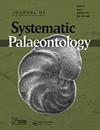Skorpiovenator bustingorryi(兽脚目,阿贝龙科)的阑尾骨学及其阿贝龙类系统发育特征的评价
IF 2.2
2区 地球科学
Q3 EVOLUTIONARY BIOLOGY
引用次数: 3
摘要
Skorpiovenator bustingorryi是一种衍生的阿贝龙类兽脚亚目恐龙,其代表是巴塔哥尼亚西北部白垩纪晚期沉积层的一具相当完整的骨骼。尽管原始论文中描述了一些特征,主要与头骨有关,但阑尾的解剖结构仍未描述。本论文的目的是对现有的附肢骨骼进行详细描述和分析,包括与其他接近Skorpiovenator的角龙类兽脚亚目的比较。通过这种方式,出现了新的自体形态,以进一步区分Skorpovenator与其亲属。此外,还进行了全面的系统发育分析,后肢的几个特征,特别是一些自体疟原虫的特征,导致了角龙和阿贝龙科新的变形特征的鉴定。这些特征可能被证明对未来的系统发育分析有用,并可能有助于解决仍令人困惑和争论的阿贝龙兽脚亚目内部关系。本文章由计算机程序翻译,如有差异,请以英文原文为准。
Appendicular osteology of Skorpiovenator bustingorryi (Theropoda, Abelisauridae) with comments on phylogenetic features of abelisaurids
Skorpiovenator bustingorryi is a derived abelisaurid theropod represented by a fairly complete skeleton from the Late Cretaceous sedimentary beds of north-western Patagonia. Although some features were described in the original paper, mainly related to the skull, the appendicular anatomy remains undescribed. The aim of the present contribution is to provide a detailed description and analysis of the available appendicular bones, including comparisons with other ceratosaurian theropods close to Skorpiovenator. In this way, new autapomorphies emerged to further distinguish Skorpiovenator from its relatives. Furthermore, a comprehensive phylogenetic analysis was performed and several characteristics of the hind limb, in particular some of the autopodium, resulted in the identification of new apomorphic traits for Ceratosauria and Abelisauridae. These features might prove to be useful for future phylogenetic analyses and may help to resolve the still confusing and debated internal relationships of abelisaurid theropods.
求助全文
通过发布文献求助,成功后即可免费获取论文全文。
去求助
来源期刊
CiteScore
5.30
自引率
7.70%
发文量
31
审稿时长
>12 weeks
期刊介绍:
The Journal of Systematic Palaeontology publishes papers that provide novel and impactful results in phylogenetics and systematics and that use these results in ways that significantly advance rigorous analyses of palaeogeography, palaeobiology, functional morphology, palaeoecology or biostratigraphy. Papers dealing with theoretical issues or molecular phylogenetics are also considered if they are of relevance to palaeo-systematists. Contributions that include substantial anatomical descriptions, descriptions of new taxa or taxonomic revisions are welcome, but must also include a substantial systematics component, such as a new phylogeny or a revised higher-level classification. Papers dealing primarily with alpha-taxonomic descriptions, the presentation of new faunal/floristic records or minor revisions to species- or genus-level classifications do not fall within the remit of the journal.

 求助内容:
求助内容: 应助结果提醒方式:
应助结果提醒方式:


